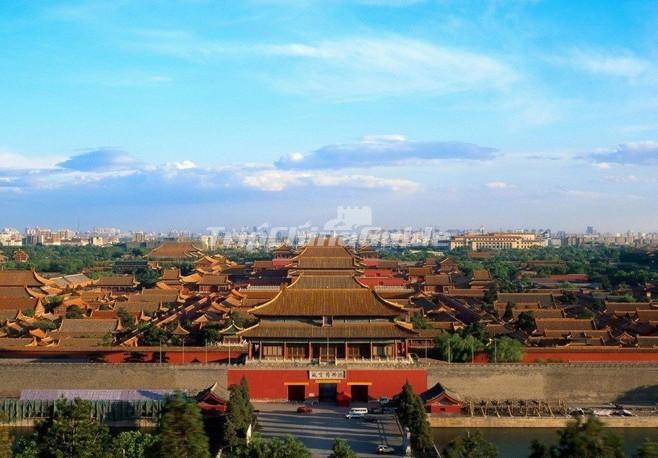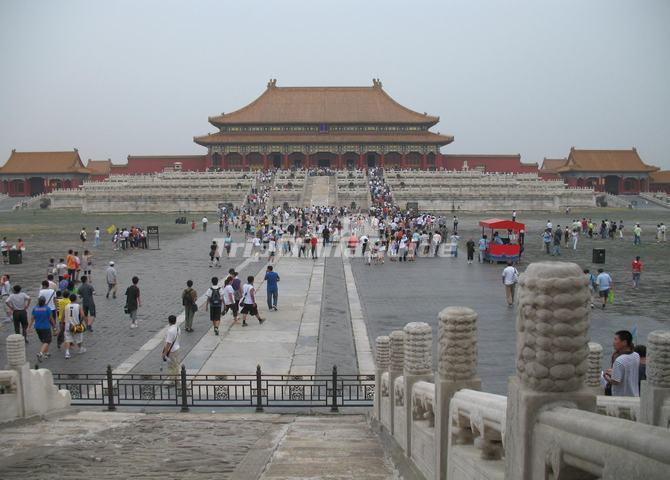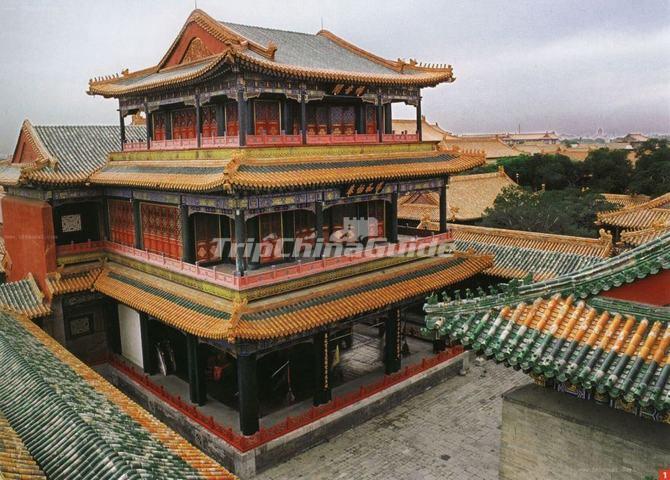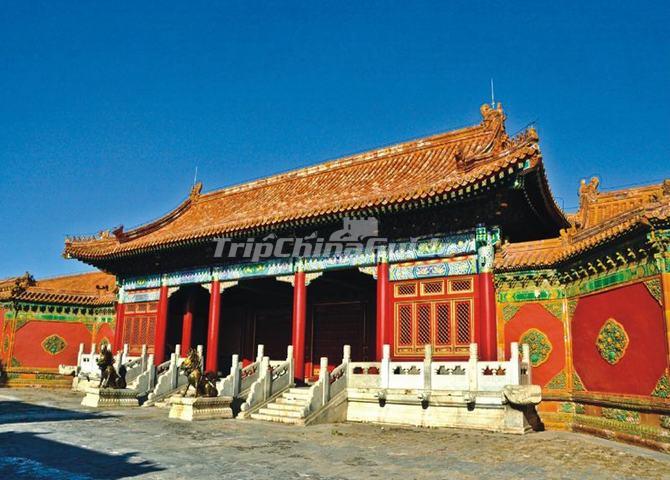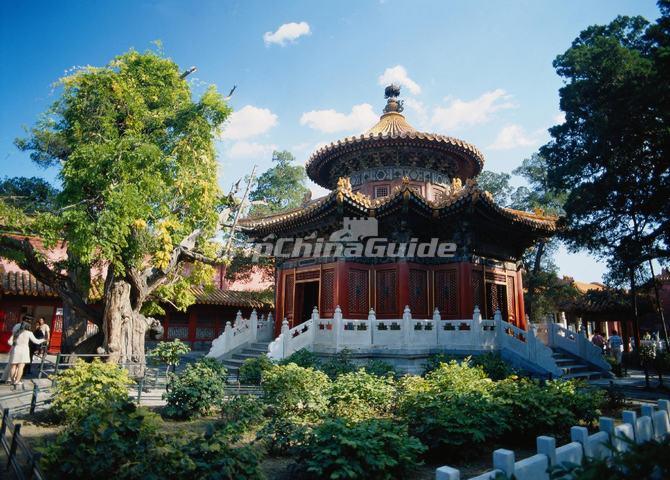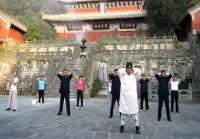Forbidden City
The former Imperial Palace, known to Westerners as the Forbidden City, rectangular in shape and 720, 000 square meters in size, is surrounded by walls 10 meters high and a moat 52 meters wide. The 980 buildings with 8,707 rooms are more than 570 years old and constitute the largest and most complete existing ensemble of traditional Chinese architecture.
Construction of the palace begins in 1406 during the reign of the third emperor of the Ming Dynasty, Yongle. It was finally completed in 1420. The Imperial Palace is composed of the outer palace, where the emperors held official audiences, and the inner palace, which served as the living quarters for the imperial family. This harmonious assemblage of buildings displays the best characteristics of ancient Chinese architecture – majestic style, flawless construction, and fine coordination of the while and the parts. Now, the Forbidden City, the Palace Museum, is a treasure house of cultural relics, and a place that attracts over 10,000 each day with its magnificent architecture and precious collections of cultural and art objects.
The Outer Court
The Imperial Palace grounds are divided into the Outer Court and the Inner Court by the Gate of Heavenly Purity. The main structures of the Outer Court are the Hall of Supreme Harmony (Taihedian), the Hall of Central Harmony (Zhonghedian) and the Hall of Preserving Harmony Baohedian. They were where the emperor held official audiences, award ceremonies, weddings, birth celebrations and official banquets. The emperor received greetings from attending officials and foreign envoys in the Hall of Supreme Harmony.
Hall of Supreme Harmony
Hall of Supreme Harmony (Taihedian), commonly known as the Hall of Gold Throne, the magnificent structure was built in 1406 and renovated in 1695. It is 35.5 meters high and has a floor space of 2,300 square meters with 182 beams and 84 pillars. It is the largest wood structure extant in China. During the Ming and Qing dynasties, the grand ceremonies such as the enthroned of the emperor, New Year’s Day, proclamation of imperial edicts, receiving successful candidates of imperial examination, and appointment of commander-in-chief of expedition troops were held here.
The interior of the Hall of Supreme Harmony is preserved as in ancient times. On the raised platform is the gilded imperial throne placed on a dais two meters high. Behind the throne is a carved screen. On either side of the throne are a crane-shaped candle-stick, an elephant-shaped incense burner and a column shaped incense burner with a pagoda on top which are all cloisonné wares.
The painted golden throne with a splendid screen behind it stands on a two-meter high dais in the center of the Hall of Supreme Harmony. Its back and the lower part are covered with coiled dragons. This is the most magnificent of all the thrones in the palace.
The Inner Court
Behind the three great halls of the Outer Court is a long open ground running from east to west, which serves as a demarcation line between the Outer Court and the Inner Court. The emperor lived in the Inner Court with his empress and scores of concubines, served by thousands of palace maids and eunuchs. The buildings in the Inner Court, like those in the Outer Court, are arranged along three lines.
The Hall of Mental Cultivation stands in a large compound south of the Six Western Palaces. During the Qing Dynasty it was the second most important place in the Imperial Palace, only next to the Hall of Supreme Harmony. The front of the hall was used as the office and the rear part as the bedroom of the emperor. The officials who were to be promoted, transferred was to expire were presented to the emperor by the Minister of interior in this hall.
The West Warm Chamber and East Chamber of the Hall of Mental Cultivation were where the emperor read official reports and met high-ranking officials. During the Qing Dynasty memorials to the throne from various offices were first sent to two collecting points and then brought to the emperor by special eunuch messengers.
The Six Western Palaces are located north of the Hall of Mental Cultivation. They are the Palace of Eternal Longevity (Yongshougong), the Palace of Assisting the Empress (Yukungong), the Palace of Gathering Elegance (Chunxiugong), the Hall of Evolution (Taijidian), the Palace of Eternal Spring (Changchungong), and the Palace of Cultivating Happiness (Xianfugong). During the Ming Dynasty they were the residence of imperial concubines. In the Qing Dynasty some empresses lived here too.
Imperial Garden
The Imperial Garden, built in 1417, is the oldest garden in Beijing. It occupies an area of 1.3 hectares at the northern end of the central axis of the former Imperial Palace. During the Qing Dynasty the emperor, empress and imperial concubines came to the garden to worship the Cowherd Star and the Girl Weaver Star on the 7th day of the 7th lunar month. On the Mid-autumn Festival they came here to offer a sacrifice to the moon, and on the double-ninth Festival the 9th lunar month they came here to ascend the Hill of Collecting Excellence in the garden and enjoy scenic beauty within and outside the Imperial Palace.
The main scenic spot in the northern part is the Hill of Collecting Excellence. The Pavilion of Imperial Landscape stands on the hill. In front of Li Zao Hall by the hill is a small pond of clear. The main scenic spot in the northwestern part is the Pavilion of Lasting Splendor. In front of the pavilion there are some ancient cypress trees over 400 years old.
Getting to the Forbidden City
It is very convenient to take public transportation to the Forbidden City. In support of the environment, please consider using public transportation.
1. By Bus:
To the Meridian Gate (Wu Men), take bus No. 1, 10, 120, 2, 20, 37, 52, 59, 728, 82, 99, Zhuan 1, Zhuan 2 to "Tiananmen East" (Tiananmen dong).
To the Gate of Divine Prowess (Shenwumen), take bus No. 101, 103, 109, 124, 609, 614, 685, Zhuan 1, Zhuan 2, to "Gugong". (Please note that the Gate of Divine Prowess has been used only as the EXIT of the museum since 2 July 2011.)
Or take bus No. 1, 10, 22, 37, 5, 52, 728 99, Zhuan 1, Zhuan 2, to "Tiananmen West" (Tiananmen Xi).
2. By Subway:
Take Subway line 1 to "Tiananmen East" or "Tiananmen West". Enter the Museum from the Meridian Gate (Wu Men).







